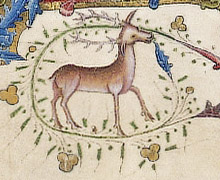Helmingham Breviary, The
Accession Number NWHCM : 1993.196
Description
manuscript, the Helmingham Breviary, a manuscript made around 1420 in Norwich for use in Norwich Diocese; leather bound with prominent transverse ridges on spine, 'BREVIARIUM' inscribed in gold leaf across; pages of Gothic handwritten text in black, red and blue ink with illuminated letters and decoration including gold leaf on page
Read MoreHelmingham Breviary, The
A breviary is a daily service book, used by monks and priests. This example was made for use in the Diocese of Norwich. By the late medieval period Norwich was the main city in East Anglia and was ranked only just below London in terms of national importance. The overwhelming significance of the Helmingham Breviary lies in its association with the city.
A record of 1422 tells of a Brother Robert of Lakenham giving a ‘new and great breviary’ to the Priory of St Leonard’s (which belonged to Norwich Cathedral Priory). Following the Dissolution of the monasteries under Henry VIII (1509-47), books which survived from monastic libraries found their way into private collections. St Leonard’s Priory was closed in 1539 and the breviary was sold to the Tollemarche family, of Helmingham Hall, Suffolk, where it remained until 1955.
The Helmingham Breviary begins with a calendar, listing the feast days of the saints. For the 24th September it includes a dedication of the Cathedral Priory of the Holy Trinity at Norwich. Its Benedictine association is reflected in the status given to the feast of the translation of St Benedict on the 11th July. The calendar is followed by a psalter, indicating which psalms should be recited, and the sanctorale, relating to saints’ days.
The book’s main textual divisions are marked by large decorated initials. Just two of these are pictorial. The illustration here shows the letter ‘T’, depicting a kneeling monk, with the Mother of Christ being carried up to heaven by two angels. He holds a scroll written in Latin, saying, ‘Holy Mother be a remedy to Robert’. It is possible that the depiction represents Brother Robert, which would be a rare portrait of such an individual at this time. The Breviary is not simply a beautiful manuscript, but shows how such wonderful products can lie behind the simple records of gifts of manuscripts. It helps to remind us of how many more such items have been lost to us.





